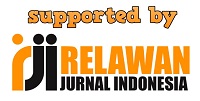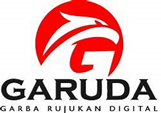PENGENDALIAN PENYAKIT LAYU FUSARIUM PISANG (Fusarium oxysporum f.sp.cubense) DENGAN SOLARISASI TANAH DAN BAKTERI ANTAGONIS
Abstract
ABSTRACT
The objective of the research is to investigate the effectiveness of soil solarization and antagonist bacteria in controlling fusarial wilt of banana.The experiment was conducted in farmer field by randomized complete block of two factors. The treatment in the field, factor A is solarization (without solarization, three weeks of solarization, and four weeks of solarization); factor B is antagonist bacteria (without bacteria, bacteria 1, and bacteria 2). The treatment is replicated three times. The number of banana’s plant for each treatments are 4-6 plants. The result of field research showed that single treatment of solarization, bacteria even combination between them did not significantly affect to suppress the incident of Foc.
Keywords: Fusarium oxysporum f.sp.cubense, soil solarization, antagonist bacteria
Keywords
Full Text:
PDFReferences
DAFTAR PUSTAKA
Campbell. CL, Madden, JW. 1990. Introduction to Plant Diseases Epidemiology. New York: JW & Sons.
Djatnika I, Hermanto C, Eliza. 2003. Pengendalian Hayati Layu Fusarium pada Tanaman Pisang dengan Pseudomonas fluorescens dan Gliocladium. J Hortikultura 13: 205-211.
Eliza. 2004. Pengendalian Layu Fusarium pada Pisang dengan Bakteri Perakaran graminae. Tesis. Institut Pertanian Bogor. Bogor.
Kartini. 1996. Solarisasi Tanah terhadap Kemampuan Tumbuh dan Patogenisitas sklerotia Sclerotium rolfsii Sacc. Skripsi. Institut Pertanian Bogor. Bogor
Katan. J, Greenberger, Alon H, and Grinstein A. 1976. Solar heating by polyethylene mulching for the control of diseased caused by soil borne pathogens. Phytopathol 66: 683-688
Katan J, and De Vay JE. 1991. Mechanism of pathogen control in solarized soil. di dalam: Katan J, and Devay J E, editor. Soil Solarization. CRC Press. Boca Raton Ann Arbor Boston. London.
Katan J, and De Vay JE. 1991. Soil solarization: historical perspective, principles, and uses. di dalam: Katan J, and Devay J E, editor. Soil Solarization. CRC Press. Boca Raton Ann Arbor Boston. London.
Katan P and De Vay J E.. 1991. Soil solarization. CRC Press. Boca Raton Ann Arbor Boston. London.
Kistler H. C., 2001. Evolution of Host Specieficity In Fusarium oxysporum. di dalam: Summerell BA., Leslie JF, Backhouse D, Bryden WL, and Burgess LW, editor. Fusarium. Nelson PE. Memorial Symposium. The American Phytopathological Society. St. Paul, Minnesota.
Landa BB, Navas-Cortes JA, Hervas A and Jimenez-Diaz RM. 2001. Influence of temperature and inoculums density of Fusarium oxysporum sp. ciceris on suppresion of fusarium wilt of chickpea by rhizosphere bacteria. Phytopathol 91: 807-816.
Larkin RP, Hopkins DL, and Martin FN. 1996. Suppresion of fusarium wilt of watermelon by nonpathogenic Fusarium oxysporum and other microorganisms recover from a disease-suppresive soil. Phytopathol 86: 812-819.
Muharam A, Djatnika I, Sulyo Y, dan Sunarjono H. 1992. Pisang Sebagai Komuditas Andalan , Prospek dan Kendalanya. Prosiding Seminar 5 Nop. 1992. Puslitbanghorti, Balithorti Lembang, Sub Balithorti Segunung. Pp. 13-18.
Pinkerton, J. 2000. Soil solarization; A perspective from a northern temperate region. USDA ARS HCRL. Corvallis.
Press CM, Loper JE. and Kloepper JW. 2001. Role of iron rhizobacteria- mediated induced systemic resistance of cucumber. Phytopathol 91: 593-598.
Semangun H. 1994. Penyakit-Penyakit Tanaman Hortikultura di Indonesia. Yogyakarta: Gadjah Mada University Press.
DOI: http://dx.doi.org/10.33512/j.agrtek.v1i1.556
Refbacks
- There are currently no refbacks.
Copyright (c) 2016 Jurnal Agroekoteknologi
INDEXED BY:
View My Stats

This work is licensed under a Creative Commons Attribution 4.0 International License.










